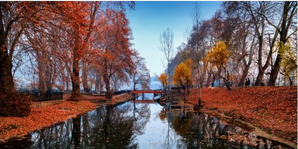Headlines
Kashmir's golden yellow autumn starts making way for winter

Srinagar, Nov 5
The king of Kashmir's four seasons, the golden yellow autumn of pleasant sunshine and plenty of fruits and grains is gradually giving way to winter. There is a nip of cold in the mornings and evenings while the autumn sunshine over a clear sky encourages locals and tourists to move around and soothe their eyes at present.
The paddy crop has been harvested and the farmers are now storing grain for the harsh winter months in their granaries.
Grapes, apples, watermelons, and vegetables are plenty in the Valley these days.
Given their experience of an unpardoning harsh winter, Kashmiris dry vegetables like brinjal, tomato, pumpkins, and even apple slices to store for the winter months.
The precious saffron crop has also been harvested and the growers are now selecting the purest quality to sell to connoisseurs of this King spice.
Pure saffron costs around Rs 2 lakh per 500 grams. It is only the rich and the famous can afford to buy saffron of that quality at that price.
The ordinary buyer would settle for half the quality for less than half the price.
Kashmir has been a landlocked Valley and the uncertainty of the Jammu-Srinagar National Highway getting closed by landslides, shooting stones, and caving in of road, has taught locals to save vegetables, food, and even LPG cylinders for the lean winter months.
All supplies of essential commodities are routed to the Valley through the Jammu-Srinagar National Highway. Rivers, streams, and lakes have clean glistening water in autumn as mountain streams bring down the last melting of the avalanches and glaciers into the Valley.
Within a fortnight or so, the snow up in the perennial water reservoirs of the Valley will stop melting and get frozen.
The sound of the Cicada bug that attaches itself to the bark of the willow tree is nature's way of telling the locals to make hay while the sun shines.
Parents are buying warm clothes for their children to make the loose overgarment called the 'Pheran' that continues to remain the most distinctive winter attire for the local population.
Interestingly, as fewer households in the Valley have access to charcoal after shifting completely to liquefied cooking gas, the earthen pot woven in willow wicker called the 'Kangri' is seen under fewer Pherans now during the winter months.
The harshest 40-day-long period of winter cold called the 'Chillai Kalan' starts on December 21 and will end on January 30.
It was during that period of bone-chilling cold that the locals used to carry the Kangri filled with hot charcoal under the Pheran to keep body and soul together.
In the evenings, one can hear the cackle of the migratory birds arriving in the Valley from far off Siberia, The Philippines, and China to spend winter months in the water bodies of Kashmir.
These armies of various plumaged avian visitors bring magic to the lakes, rivers streams, and bird reserves of Kashmir during the winter months.
These armies of avian visitors start arriving here in late October and remain in the Valley till late April.
Kashmir hosts various species of migratory birds, including the grey leg geese, mallards, teals, coots, wigeons, Pochards, shovelers, and Brahmany ducks during the winter months.
Some birds of passage like the cormorants and Sandhill cranes also arrive here in late autumn to spend a few days before they leave for the Indian plains.
With electric power still playing hide and seek as curtailments, shutdowns, and rotations by the Electric Department make electricity hard to come by in local homes, it is time for the children to hurdle themselves closer to grandparents for stories of kings, queens, and demons of the bygone days.
Whatever, way one looks at Kashmir in whichever season, the Tourism Department slogan 'You Just Can't Have Enough of Kashmir' seems to hold good.



































